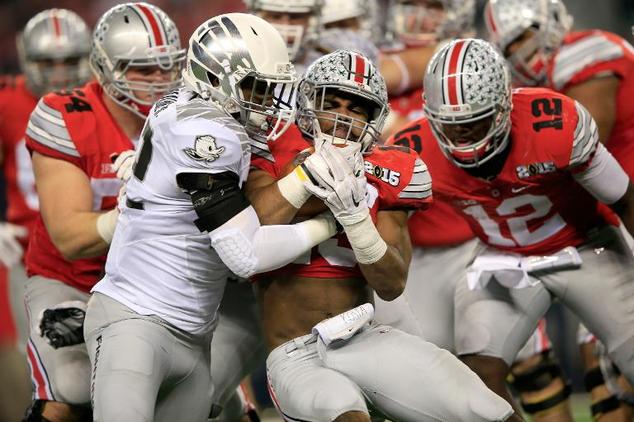
Three members of the University of Oregon's football team were left in hospital last week following the punishing fitness session, which was described in media reports as military-style training that had included one hour of continuous push-ups.
At least one of the three, lineman Sam Poutasi, was diagnosed with rhabdomyolysis, a potentially deadly condition which occurs when broken down muscle tissue leaks into the blood stream.
Carmelo Anthony irked at questioning of his loyalty
On Tuesday, the University of Oregon suspended the strength and conditioning coach responsible for the session, Irele Oderinde, while the head of the football program issued a public apology.
"The university holds the health, safety and well-being of all of our students in high regard," said Rob Mullens, Oregon's director of athletics. "We are confident that these athletes will soon return to full health, and we will continue to support them and their families in their recoveries."
The university said future workouts would be "modified" while noting that the football program's strength and conditioning coach would now report directly to the college's director of performance and sports science.
Antetokounmpo show not enough to save Bucks
The case provoked an angry response from Cleveland Browns offensive tackle Joe Thomas, who wrote on Twitter that it highlighted a failure of college sport's governing body, the National Collegiate Athletic Association.
"Whoever is behind this should be fired, nothing to do with football," Thomas wrote. "Where's NCAA? How about protecting athletes instead of your paychecks! These are the petty games 'coaches' play when they are clueless about actually coaching the game and developing the kids. It gives football a bad name."
The Oregon case is not unique. Since 2000, there have been 21 recorded deaths of college football players linked to participation in conditioning workouts.
Rockets tear Nets apart as Harden shines
Although mass hospitalizations from rhabdomyolysis in college athletes remain rare, the Oregon case comes only five months after eight female volleyball players at a Texas college were treated for the condition.
In 2011, 13 athletes at the University of Iowa's football program were hospitalized after a similarly punishing workout.
Jay Hoffman, professor of sport and exercise science at the University of Central Florida, said the Oregon case highlighted the need for minimum entry standards for strength coaches.
"A situation where an athlete is injured to the point where rhabdomyolysis has occurred is a clear issue of negligence and inappropriate exercise prescription," Hoffman told AFP. "It's not common but it happens way too often. It's something that should never occur.
"What needs to happen is that we have minimum standards that are accepted by universities in the hiring process. Strength coaches that are hired need to have a degree in exercise science and a certification from an accredited body."
Hoffman said at present there was no formal requirement by the NCAA for coaches to have appropriate certification.
"You can have a maths major coaching football players or basketball players. Someone with no knowledge of the human body, or the effects of training on the human body," said Hoffman.
"Just think about a football coach who starts training in the middle of the summer and lasts until January. You're going through two potential environmental extremes — hypothermia and hyperthermia.
College programs needed to revise the reporting structure within each department — as Oregon has now done after the recent case — so that strength and conditioning coaches were not hired and fired by the head football coach.
"The problem is that the strength coach is often answerable to the football coach," said Hoffman. "If he has been hired by the football coach, that's who he is going to listen to. And that is sometimes in contrast to what's in the best interests of the student athlete."






































COMMENTS
Comments are moderated and generally will be posted if they are on-topic and not abusive.
For more information, please see our Comments FAQ